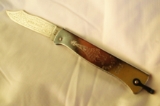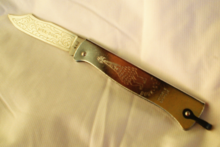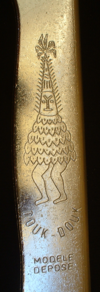
Douk-Douk
Encyclopedia
The douk-douk is a French pocketknife
of simple sheet-metal construction. It has been manufactured by the M. C. Cognet cutlery
firm in Thiers
, France, since 1929.

. The handle depicts a "douk-douk", or Melanesian spirit incarnation. Cognet based the design on an engraving in an illustrated dictionary. Later other designs such as the "El Baraka" and "Tiki" were developed for other regional markets, particularly in French Algeria
, and even down into Sub-Saharan Africa.
Originally intended as an inexpensive utility pocket knife for the ordinary working man, the popularity of the douk-douk caused it to be pressed into service as a weapon when necessary. During the 1954-1962 FLN
-led revolt in Algeria, the douk-douk was used as weapon of assassination and terror; Algerians who ran afoul of the FLN frequently had their noses removed by the knife's razor-sharp blade. It could easily be converted from a folding-blade pocket knife into a useful fixed-blade dagger by the simple expedient of hammering the ends of the sheet-metal handle together behind the blade's bolster, locking the blade into the full-open position.

knife, having no locking mechanism, but only a very strong backspring to bias it towards opening and closure. It consists of only six parts:
The cutlery firm of M.C. Cognet has continued to build the knife up to the present day, using the same simple methods. Today they are offered with several decorative designs, stainless or carbon steel blades, in three different sizes.
Out-of-production variants
Pocket knife
A pocket knife is a folding knife with one or more blades that fit inside the handle that can still fit in a pocket. It is also known as a jackknife or jack-knife...
of simple sheet-metal construction. It has been manufactured by the M. C. Cognet cutlery
Cutlery
Cutlery refers to any hand implement used in preparing, serving, and especially eating food in the Western world. It is more usually known as silverware or flatware in the United States, where cutlery can have the more specific meaning of knives and other cutting instruments. This is probably the...
firm in Thiers
Thiers
Thiers is a French surname. Notable persons with the surname include:*Adolphe Thiers , French statesman and historian*Louisa Thiers , American supercentenarian*Harry D...
, France, since 1929.

Design origins
The external engraving of the douk-douk was created in 1929 by Gaspard Cognet of Cognet, Antoine & Gaspard for sales to France's colonies on OceaniaOceania
Oceania is a region centered on the islands of the tropical Pacific Ocean. Conceptions of what constitutes Oceania range from the coral atolls and volcanic islands of the South Pacific to the entire insular region between Asia and the Americas, including Australasia and the Malay Archipelago...
. The handle depicts a "douk-douk", or Melanesian spirit incarnation. Cognet based the design on an engraving in an illustrated dictionary. Later other designs such as the "El Baraka" and "Tiki" were developed for other regional markets, particularly in French Algeria
French Algeria
French Algeria lasted from 1830 to 1962, under a variety of governmental systems. From 1848 until independence, the whole Mediterranean region of Algeria was administered as an integral part of France, much like Corsica and Réunion are to this day. The vast arid interior of Algeria, like the rest...
, and even down into Sub-Saharan Africa.
Originally intended as an inexpensive utility pocket knife for the ordinary working man, the popularity of the douk-douk caused it to be pressed into service as a weapon when necessary. During the 1954-1962 FLN
National Liberation Front (Algeria)
The National Liberation Front is a socialist political party in Algeria. It was set up on November 1, 1954 as a merger of other smaller groups, to obtain independence for Algeria from France.- Anticolonial struggle :...
-led revolt in Algeria, the douk-douk was used as weapon of assassination and terror; Algerians who ran afoul of the FLN frequently had their noses removed by the knife's razor-sharp blade. It could easily be converted from a folding-blade pocket knife into a useful fixed-blade dagger by the simple expedient of hammering the ends of the sheet-metal handle together behind the blade's bolster, locking the blade into the full-open position.

Description
The douk-douk is a very simple slipjointSlipjoint
A slipjoint knife is one of the most ubiquitous types of pocketknives.A slipjoint knife consists of a handle with one or more folding blades. These blades are held in position by a strong "backspring" which biases them towards the open or closed position...
knife, having no locking mechanism, but only a very strong backspring to bias it towards opening and closure. It consists of only six parts:
- A folded sheet-metal handle, which is very slim
- A carbon steel blade, of a soft and easily-sharpened steel, generally of the "Turkish clip" profile reminiscent of a scimitar. The blade has indentations at the back, and is decorated with acid-engraved arabesqueArabesqueThe arabesque is a form of artistic decoration consisting of "surface decorations based on rhythmic linear patterns of scrolling and interlacing foliage, tendrils" or plain lines, often combined with other elements...
s. The blade has no nail-nick, but is easily grasped for opening since it tapers at the spine. - A strong backspring
- Two rivets (one to hold the blade, the other to hold the backspring and bail)
- A metal bail or lanyard loop
The cutlery firm of M.C. Cognet has continued to build the knife up to the present day, using the same simple methods. Today they are offered with several decorative designs, stainless or carbon steel blades, in three different sizes.
Variants
Current variants- Sorcier—black handle, engraved with the image of "Douk Douk", a PolynesianPolynesian mythologyPolynesian mythology is the oral traditions of the people of Polynesia, a grouping of Central and South Pacific Ocean island archipelagos in the Polynesian triangle together with the scattered cultures known as the Polynesian outliers...
mythical figure - El-Baraka—nickel-plated handle, engraved with a BerberBerber mythologyThe traditional Berber mythology is the ancient and native set of beliefs and deities developed by the Berber people in their historical land of North Africa...
star (allegedly marketed to Muslim colonies in North Africa where the humanoid figure of the Sorcier model would be culturally inappropriate) - Tiki—engraved with a Polynesian tikiTikiTiki refers to large wood and stone carvings of humanoid forms in Central Eastern Polynesian cultures of the Pacific Ocean. The term is also used in Māori mythology where Tiki is the first man, created by either Tūmatauenga or Tāne. He found the first woman, Marikoriko, in a pond – she seduced him...
idol - L'écureuil—nickel-plated handle, engraved with a squirrel. Primarily marketed within France. Unlike most other variants, L'écureuil has a spear profile blade.
Out-of-production variants
- (several variants of the Douk-Douk are no longer in production)
Sources
- Gérard Pacella. Couteaux de nos Terroirs. Editions de Borée, 2005. ISBN 284494325X, 9782844943255. Pg. 26 http://books.google.com/books?id=98v2moW9tEUC&pg=PA27&dq=douk-douk#PPA24,M1

